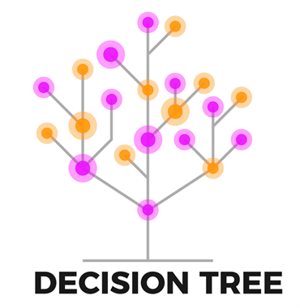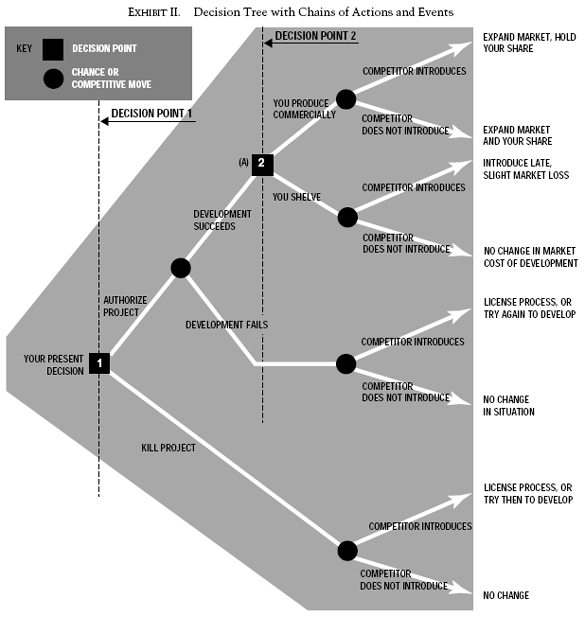 Originally published: 2/15/2021
Originally published: 2/15/2021
Updated: 3/4/2024
For those not familiar with the term, a decision tree is a flow chart that works through all possible response options in a scenario to analyze resulting outcomes. Basically, it is a visual version of an “if this then that” statement across all possible alternatives.
The “branches” off each decision alternative that result use data analysis to forecast the most likely outcome of each decision. When one decision leads to another decision that must be made, that branch splits to continue extrapolating the effects of each subsequent decision. The result is a tree-like diagram (hence the name) that is easy to understand and interpret.
Decision trees can be more conceptual in nature or have numbers to back up decision scenarios, as is the case of pricing changes affecting revenue figures. For decision trees with complicated calculations, a software program can assign values and probabilities to streamline decision-making. A decision tree is a critical part of strategic planning because it allows decision makers to analyze the effects of a significant change throughout different areas of the business.
Aiding in Complex Decisions
Executive leadership can use a decision tree to assist with making complicated business decisions such as:
- Downsizing
- Outsourcing critical functions
- Expanding into new markets
- Changing pricing models
- Relocating
- Selling the business
- Changing product offerings
- Expanding research and development efforts
For instance, a decision tree can aid in succession planning by allowing business owners to evaluate possible options like passing the business onto an heir, selling to a co-owner, selling to a third-party, or selling an ownership stake back to the company.
A sample decision tree from the Harvard Business Review illustrates how a business may decide whether to move forward with a new development project:

Kevin Briscoe offers business leaders the following steps to supplement decision-tree building in approaching business challenges when the path forward isn’t clear:
- Be open-minded to things you may not want to hear.
- Draw on existing experience.
- Solicit ideas both internally and externally.
- Consider what it will mean to do nothing.
- Evaluate what you have learned.
He explains that this approach is essential for addressing complex financial management issues during the decision tree making process to resolve pressing business challenges quickly and effectively.
Responding to Changes
Decision trees are also commonly used by companies looking to respond to market trends or business disruptions such as:
- A natural disaster
- Regulatory changes
- A market downturn
- The emergence of a new technology
- Supply chain delays
- Materials shortages
- Increased industry competition
- Shifting consumer needs
Jeff Dunn discusses how CFOs can use a decision tree-type mentality in determining what to focus on next during times of great change when he says,
“Brainstorm, discuss with business leaders and advisors, play out all the reasonably likely scenarios then build financial models for each. Figure out what works and what does not. Put a plan in place to execute swiftly when the external factors shift and/or variables become known. Know what you are going to do and when you are going to do it based on changing conditions.”
Planning for Worst-Case Scenarios
Additionally, companies looking to be prepared for a worst-case scenario may also use a decision tree as part of a proactive crisis management strategy. In this case, leadership will identify possible triggers for a significant business disruption and work through the impacts of each to create a well-articulated response plan that anticipates business barriers:
“During a worst-case scenario, leadership must decide whether the organization will make the necessary adjustments needed to continue with business as usual or change how the company will operate. And while the conversation will undoubtedly include operational and capacity considerations, it is primarily a discussion about financial capabilities.”
Since these types of decision trees can become quite involved, triggers are typically ranked in order of likelihood and impact so that business leadership can focus their time on the most probable threats as well as those that are most likely to severely affect cash flow.
In this way, a decision tree can help to mitigate business risk – whether it be economic, financial, social, or political. Scott Fowle suggests leveraging financial models, KPIs, forecasting, and the annual planning process to better understand organizational risk and prepare accordingly.
When you are ready to improve your strategic planning, download a decision tree PowerPoint template to get started. Then, work with a trusted financial leader to ensure that your organization can effectively plan for whatever is coming next. Our experienced team of CFO consultants can come alongside your organization to provide the right amount of financial leadership to help you succeed. Whether you need occasional planning assistance or ongoing part-time financial leadership, our fractional CFO services can offer as much or as little help as you need!







